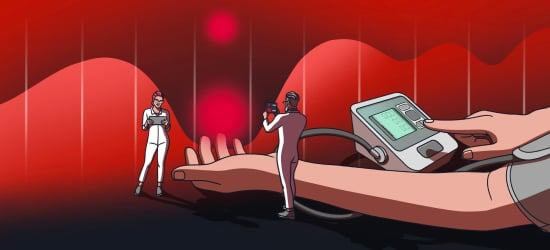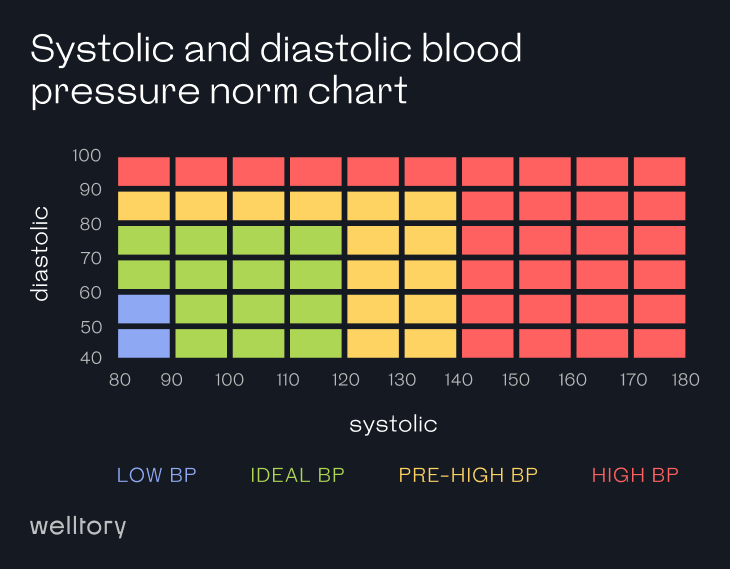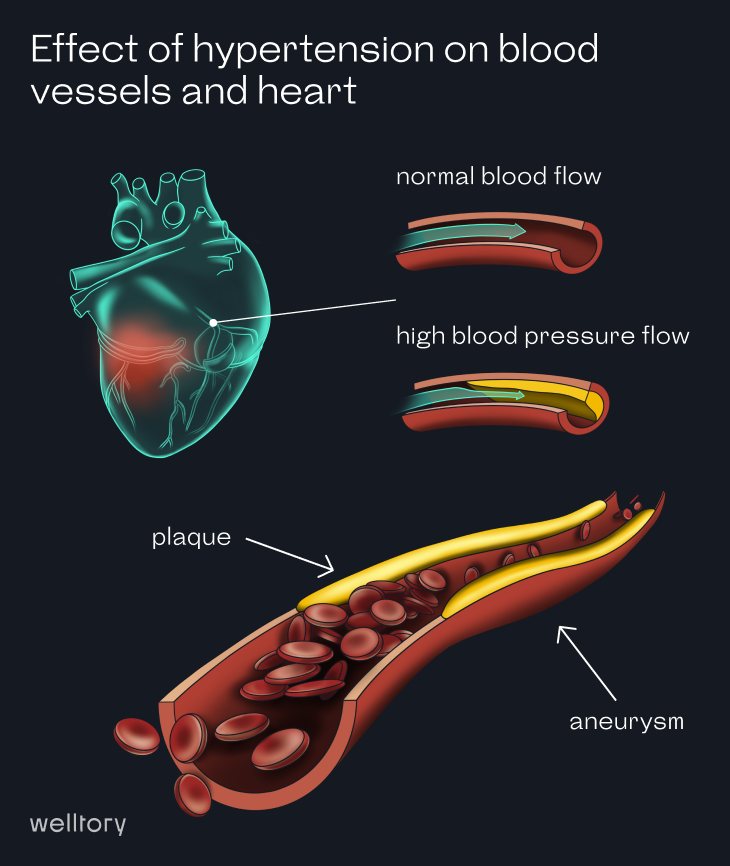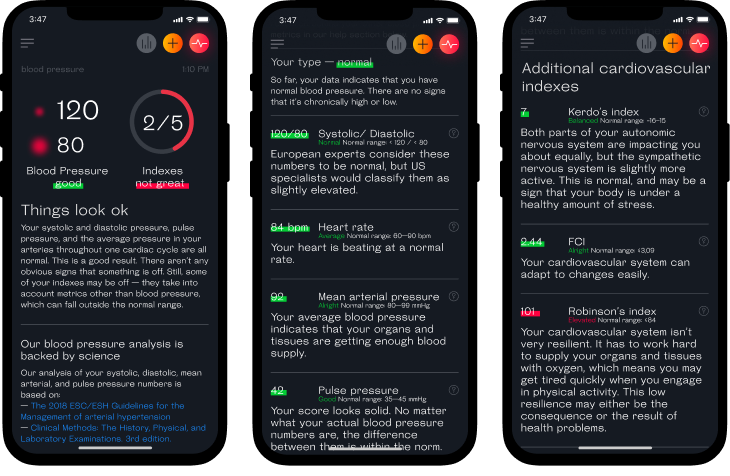

Welltory is the Ultimate HRV App




Home » Blood Pressure » What is Blood pressure and how to analyze it with Welltory?

Blood pressure is a key indicator of cardiovascular health. A blood pressure reading that falls outside the norm can signal that your health could be at risk. While health risks exist on both low and high ends of blood pressure, high blood pressure is of the greatest concern for many people. One of the deadliest things about high blood pressure (hypertension) – often there are no symptoms unless it’s severe. Therefore, it is a good idea to regularly monitor blood pressure, especially if you have family members with known cardiovascular issues. For example, almost every other adult in the U.S. has high blood pressure, according to the U.S. Department of Health and Human Services. Let’s explore how to stay on top of your blood pressure monitoring.
Blood pressure (BP) is recorded with two numbers separated by a slash e.g. 120/80. The top number is the systolic pressure, it’s the force at which your heart pumps blood around your body. The bottom number is the diastolic pressure – the resistance to the blood flow in the blood vessels or the pressure in your arteries in between heartbeats. These numbers are measured in millimeters of mercury (mmHg). Blood pressure is checked with a special monitor, ideally, you would want to use an upper arm monitor. According to the European Society of Cardiology/European Society of Hypertension (ESC/ESH), healthy blood pressure is considered to be between 90/60mmHg and 120/80mmHg, whereas high blood pressure is considered to be 140/90mmHg or higher. If your BP readings are between 120/80mmHg and 140/90mmHg, you are at risk of developing high blood pressure in the future. Moreover, it is also important to monitor the difference between systolic and diastolic pressure (pulse pressure). For example, increased pulse pressure correlates with an increased risk of major cardiovascular complications.

To understand your blood pressure better, you can insert BP readings into the Welltory app. It will analyze your readings and present you with a complete interpretation of your BP according to the 2018 ESC/ESH. Please note that Welltory cannot take blood pressure readings — you’ll need to use a manual or a smart blood pressure monitor. Here you can find a lot of helpful information and tips on how to enter the data in the app to get the best out of it.
Let’s start with low blood pressure before we move onto high BP. Low blood pressure or hypotension is a reading of less than 90/60mmHg. Blood pressure can naturally vary throughout the day, but if it stays low (even if there are no symptoms), we suggest you see a doctor. Moreover, there can be noticeable signs and symptoms, such as dizziness and nausea, pale skin, fatigue, and fainting, which will signal you that something is wrong.
Clinically low BP can be caused by a temporary issue, such as dehydration or blood loss, or a more long-term one, such as a heart condition. There are many possible causes of low blood pressure. It may be low because you’re fit (and it’s not a typo!), you could have inherited it from your parents, or you can develop low blood pressure with age. Pregnancy might be another cause of low BP. Some drugs can cause low blood pressure. Moreover, low BP can be a result of an allergic reaction to a medication or certain foods. Problems with the endocrine system and anemia can also result in hypotension.
Treatment for hypotension usually depends on the cause if it can be found. Often medicine to increase blood pressure isn’t needed and simple lifestyle measures are usually effective. Healthcare providers recommend avoiding sitting or standing for long periods, don’t bend, change posture or get up suddenly. Increase the amount of water you drink and limit your consumption of caffeinated drinks at night and alcohol. Eating small but frequent meals and staying still for a while after eating may also help.
Many of the side effects of low blood pressure can affect the quality of your life. If you experience any of the symptoms of hypotension we recommend you measure your BP and consult with your doctor.
High blood pressure, otherwise known as hypertension, is a common disease that develops when blood flows through your arteries at pressures higher than what’s considered normal (for reference, please see above). High blood pressure has many risk factors, including age: before age 64, hypertension is more common in men; women are more likely to develop it after age 65. Moreover, race is another risk factor. Hypertension is particularly common among people of African heritage, often developing at an earlier age than it does in other races.
High BP usually develops over time, gradually. The most common cause of hypertension is an unhealthy lifestyle, lack of regular physical activity, excess smoking, high alcohol consumption, a poor diet, and even stress. It can also be caused by health conditions such as diabetes and/or obesity. Women can also be at risk of developing hypertension during pregnancy.
There are usually no clear symptoms from high blood pressure, until it is severe enough to cause serious health problems, and this is exactly why it is important to have your blood pressure checked regularly. U.S. National Heart, Lung, and Blood Institute refers to hypertension as a “silent killer”. Having BP under control can help you to prevent or avoid serious health problems such as heart attack, heart failure, and stroke. In addition to that, there are other serious diseases associated with high blood pressure, for example, chronic kidney disease, dementia, and eye damage.
Relying only on your symptoms and feelings is an unreliable way to get a sense of one’s blood pressure. A few people with high blood pressure may have headaches, nosebleeds, or shortness of breath. However, these signs are not specific and rarely occur until high BP has reached a severe stage. Moreover, it’s wrongfully believed that facial flushing and dizziness can indicate hypertension. You can experience facial flushing while your BP is high, but it’s not a direct cause of facial flushing. Dizziness on the other hand can be a sign of low blood pressure, or a stroke if it’s very sudden. This being said, we urge you to see a doctor if you experience any of the above symptoms and have BP readings above or below the norm.
It’s common knowledge that high blood pressure is an unhealthy sign and can lead to heart-related issues, stroke, or even sudden death. However, there are more various side effects on your body that you should know about. Let’s talk about them in simple terms.
First of all, high blood pressure puts stress on your heart and your arteries even if you don’t experience any symptoms. Over time, it can affect blood flow and, hence, all of the tissues and organs in your body.
Blood vessels that push blood through your body have a smooth inner lining. They’re strong and flexible. High blood pressure applies an extra force to the blood flow that can damage cells on the arteries’ inner lining. If the pressure doesn’t subside, this lining tears and its walls are not smooth anymore. This process causes fatty bits, called plaque, to clog up in your blood vessels over time, preventing blood from moving freely. Eventually, the clogging can make the artery wall stretch, creating a bump. This is called an aneurysm. Aneurysms can break open and bleed, causing significant health issues and even death.
The heart must work harder than usual to pump blood through clogged arteries. It can increase in size if it’s overworked, which will lead to loss of strength of the heart’s walls. This can lead to irregular heartbeat, chest pain, and end in heart attack or heart failure.

High blood pressure is the biggest cause of stroke because it can cause a block of blood flow. Even if the blocked blood flow does not cause a stroke, it can affect parts of the brain responsible for speech, vision, hearing, movement and coordination, sleep, memory, and emotions. If the blood flow is not improved then the damage can be permanent. Decreased blood supply affects memory and stops one from thinking clearly. It can lead to vascular dementia, which occurs when vessels that supply blood to the brain become blocked or narrowed.
Eyes and vision can be affected by high blood pressure. Hypertension can damage blood vessels in the retina – the area at the back of the eye where images focus. This eye disease is known as hypertensive retinopathy and can be very dangerous if not treated. Blocked blood flow can also damage the optic nerve, leading to bleeding within your eye or even vision loss.
People with high blood pressure can also develop kidney disease. When the vessels get clogged, the kidneys don’t get enough oxygen and nutrients and struggle to filter waste from the body. Moreover, kidneys take part in controlling blood pressure. When they are not healthy and don’t function properly, BP can increase. This becomes a vicious cycle that can lead to kidney failure.
High blood pressure can also hit you below the belt. Hypertension is likely to lead to excess urination, as it’s associated with extra fluid in your body. This in turn can result in your body getting rid of too much calcium, an element that is important for your bones’ strength. Excessive urination leads to loss of electrolytes, which can affect the myocardium’s function. Moreover, reduced blood flow to the genitals can lead to erectile dysfunction, decreased libido, and/or difficulty achieving orgasm.
A research suggests that during COVID-19 a degradation of lung function may be associated with a rise in BP. Although COVID-19 is known as respiratory disease, it might also be considered a vascular disease resulting in hemodynamic instability.
Any sort of health condition, from asthma to diabetes, increases your risk of developing serious symptoms caused by COVID-19. Hypertension is no exception. Moreover, people with heart-related conditions may be amongst the most vulnerable. For example, in China, the mortality rate for people with high blood pressure is higher than for people with normal BP. In the U.S. there is 40 percent of hospitalized patients, who have cardiovascular disease or cerebrovascular disease according to The American Heart Association.
We have already established why and how important it is to keep your blood pressure under control. Let’s look at how to measure your BP and what the best time and place for doing so is. Although Welltory cannot measure your BP, it can analyze the data and help you and your doctor to track changes in your blood pressure.
While checking BP in medical settings might imply it is measured correctly technically, measuring your BP at home on a regular basis is a good idea. The term “white coat effect” describes a feeling that patients have at the doctor’s office. Some experience anxiety or negative emotions, fear, and stress that can lead to an increased BP. The Hisayama study compared measurements of visit-to-visit blood pressure variability (BPV) based on office blood pressure measurements with measurement of day-to-day BPV with home blood pressure monitoring. Day-to-day measurements outside of the doctor’s office proved to be more reliable and allowed doctors to optimize blood pressure management most effectively. However, the diagnosis itself can only be made by a doctor and on an outpatient basis.
We recommend taking readings at the same time of day each day so you can track trends and changes. Consider having a blood pressure log or diary. Ideally, you will want to take measurements once in the morning and once in the evening.
You can use a blood pressure monitor and follow some simple rules suggested by Harvard Medical School and the Mayo Clinic:
The Welltory app will help you understand your blood pressure readings better, and if you are already prescribed a treatment, then tracking your BP with Welltory will help your doctor see how well the prescribed treatment is working. On top of blood pressure, if we have your heart rate data, Welltory analyzes five other indexes that give you a bigger picture of your overall cardiovascular system.
Well, there are indeed some blood pressure smartphone apps that can help you monitor your blood pressure, but they cannot actually check blood pressure – only a proper monitor can. According to eMedicineHealth, a few Android apps claimed they could “measure” BP by reading the pulse when the user’s finger is held against the phone’s camera or a screen. However, we ask you to note that phone apps cannot check your BP. If you are a big gadget fan and think that a simple BP monitor is old-school, you can use a smart tonometer (check Qardio, Omron, iHealth, Medisana, or Withings) that will share your data with Welltory. Welltory will connect with your Apple Health, Samsung Health, and Google Fit.

The DASH eating plan recommends eating vegetables, fruits, and whole grains. Include dairy products and products that contain healthy fats such as fish, poultry, beans, nuts, and vegetable oils in your diet. Reduce your sodium intake. Limit sugar-sweetened beverages, sweets, and foods that are high in saturated fat, such as fatty meats, full-fat dairy products, and tropical oils such as coconut, palm kernel, and palm oils.
Eat more:
Limit:
Being physically active and keeping yourself at a healthy weight! To calculate whether your weight is in a healthy range, you can use body mass index (BMI). The general guideline suggests at least 2 hours and 30 minutes of moderate-intensity exercise, such as walking or bicycling, every week. This is only about 30 minutes a day, 5 days a week. Very achievable even if you have a busy schedule. Welltory can offer you a personalized Move plan that will take into account your individual circumstances and lifestyle and will help you move more without being out of breath.
We know that some lifestyle adjustment recommendations might sound quite boring (who doesn’t like a late movie night with pizza?!) but taking these little steps regularly will improve your overall health and lower your risks of getting diseases associated with blood pressure. The Welltory app will help you enjoy tracking your health measurements and turn it into a fun activity.
Welltory Team, 20 Jan. 2023
 App Store
App Store
 Google Play
Google Play
 Huawei AppGallery
Huawei AppGallery
 Galaxy Store
Galaxy Store

